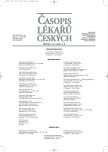-
Články
Top novinky
Reklama- Vzdělávání
- Časopisy
Top články
Nové číslo
- Témata
Top novinky
Reklama- Kongresy
- Videa
- Podcasty
Nové podcasty
Reklama- Kariéra
Doporučené pozice
Reklama- Praxe
Top novinky
ReklamaNačasování první endomyokardiální biopsie po transplantaci srdce při indukční imunosupresivní terapii
Timing of the First Endomyocardial Biopsy in Heart Transplantation after Induction Immunosuppressive Therapy – Experience from Canadian Heart Transplant Centre
Background.
The exact time point at which the first endomyocardial biopsy could be safely performed after the heart transplantation has not been systematically studied. In an attempt to determine this time point in our population, the number and severity of acute rejection episodes in the first eight weeks after the heart transplantation were assessed in 91 patients who underwent the procedure at St Paul’s Hospital, Vancouver between September 1996 and December 2002.Methods and Results.
For the purpose of our analysis, acute rejection was defined as the grade ≥2 according the International Society for Heart and Lung Transplantation (ISHLT). Three hundred and sixty two endomyocardial biopsies were performed in 87 patients surviving to the first biopsy from one to eight weeks after the heart transplantation.
In 85 patients who received induction immunosuppressive therapy, 13 episodes of acute rejection were identified. In two patients who did not receive the induction therapy, three episodes of acute rejection occurred. Acute rejection grade ISHLT 3 was found in 2 patients who did not receive induction therapy and in three patients who did. ISHLT grade 4 rejection occurred at weeks 5 and 7 in two patients who received induction therapy. Only one patient who received induction therapy had acute rejection within the first three weeks after the heart transplantation.Conclusions.
Our analysis reveals that the frequency of acute rejection within the first eight weeks after the heart transplantation using induction therapy is low in this cohort, suggesting that the first routine endomyocardial biopsy could be delayed until the week four post-transplant.Key words:
heart transplantation, endomyocardial biopsy.
Autoři: F. Málek; A. Kaan 1; L. Straatman 1; A. Cheung 1; A. Ignaszewski 1
Působiště autorů: Prague, Czech Republic ; St Paul’s Hospital, Vancouver, British Columbia, Canada ; Department of Internal Medicine I Faculty Hospital Kralovske Vinohrady, Third School of Medicine, Charles University
Vyšlo v časopise: Čas. Lék. čes. 2005; 144: 507-509
Kategorie: Aktuální téma
Souhrn
Východisko.
Vhodný časový interval, kdy se může bezpečně provést endomyokardiální biopsie po transplantaci srdce, nebyl dosud studován. Pro určení tohoto časového intervalu v naší populaci jsme analyzovali počet a závažnost episod akutní rejekce v průběhu prvních osmi týdnů po transplantaci u 91 pacientů, kteří byli operování v St Paul’s Hospital, Vancouver mezi zářím 1996 a prosincem 2002.Metody a výsledky.
Pro potřeby naší analýzy byla akutní rejekce definována jako stupeň ≥2 podle International Society for Heart and Lung Transplantation (ISHLT). Odebrali jsme 362 endomyokardiálních biopsií od 87 pacientů. U 85 pacientů, u kterých byla indukována imunosupresivní terapie, se vyskytlo 13 epizod akutní rejekce. U dvou pacientů bez indukční imunosupresivní terapie se vyskytly tři případy rejekce. Akutní rejekce stupně 3 (ISHLT) se vyskytla u dvou pacientů, u kterých nebyla indukční terapie použita, a u tří, u kterých byla. Rejekce stupně 4 (ISHLT) se objevila v 5 a 7 týdnu u dvou pacientů s indukční terapií. Pouze u jednoho pacienta s indukční terapií se akutní rejekce projevila během prvních tří týdnů po transplantaci srdce.Závěry.
Analýza prokázala, že frekvence akutní rejekce během prvních osmi týdnů po transplantaci srdce je při indukční imunosupresivní terapii v naší vyšetřované skupině nízká. To naznačuje, že první rutinní endomyokardiální biopsie může být odsunuta do čtvrtého týdne po transplantaci.Klíčová slova:
transplantace srdce, endomyokardiální biopsie.
Štítky
Adiktologie Alergologie a imunologie Angiologie Audiologie a foniatrie Biochemie Dermatologie Dětská gastroenterologie Dětská chirurgie Dětská kardiologie Dětská neurologie Dětská otorinolaryngologie Dětská psychiatrie Dětská revmatologie Diabetologie Farmacie Chirurgie cévní Algeziologie Dentální hygienistka
Článek vyšel v časopiseČasopis lékařů českých
Nejčtenější tento týden
- Metamizol jako analgetikum první volby: kdy, pro koho, jak a proč?
- Pomůže AI k rychlejšímu vývoji antibiotik na kapavku a MRSA?
- Horní limit denní dávky vitaminu D: Jaké množství je ještě bezpečné?
- S prof. Vladimírem Paličkou o racionální suplementaci kalcia a vitaminu D v každodenní praxi
-
Všechny články tohoto čísla
- Načasování první endomyokardiální biopsie po transplantaci srdce při indukční imunosupresivní terapii
- Současné názory na profylaxi žilní trombózy v chirurgii
- Věkem podmíněná makulární degenerace
- Onemocnění štítné žlázy u onkologicky nemocných
- Úloha jednotlivých nutričních faktorů v redukčním režimu
- Bolest paty
- Výživa kojenců a batolat: Doporučení WHO a informace, se kterými se setkávají čeští rodiče
- Srovnání výskytu neinvazivních rizikových znaků náhlé srdeční smrti u nemocných léčených trombolýzou a přímou angioplastikou infarktové tepny
- Drogy a dopravní nehody
- Využití psychoterapie u pacientů s kombinovanými epileptickými a neepileptickými záchvaty
- Transplantace jater dítěte od živého příbuzenského dárce
- Úrazy hlavy a alkohol
- Telefonní linky jako součást komplexní nabídky služeb pro odvykání kouření
- Časopis lékařů českých
- Archiv čísel
- Aktuální číslo
- Informace o časopisu
Nejčtenější v tomto čísle- Úrazy hlavy a alkohol
- Transplantace jater dítěte od živého příbuzenského dárce
- Bolest paty
- Výživa kojenců a batolat: Doporučení WHO a informace, se kterými se setkávají čeští rodiče
Kurzy
Zvyšte si kvalifikaci online z pohodlí domova
Autoři: prof. MUDr. Vladimír Palička, CSc., Dr.h.c., doc. MUDr. Václav Vyskočil, Ph.D., MUDr. Petr Kasalický, CSc., MUDr. Jan Rosa, Ing. Pavel Havlík, Ing. Jan Adam, Hana Hejnová, DiS., Jana Křenková
Autoři: MUDr. Irena Krčmová, CSc.
Autoři: MDDr. Eleonóra Ivančová, PhD., MHA
Autoři: prof. MUDr. Eva Kubala Havrdová, DrSc.
Všechny kurzyPřihlášení#ADS_BOTTOM_SCRIPTS#Zapomenuté hesloZadejte e-mailovou adresu, se kterou jste vytvářel(a) účet, budou Vám na ni zaslány informace k nastavení nového hesla.
- Vzdělávání



